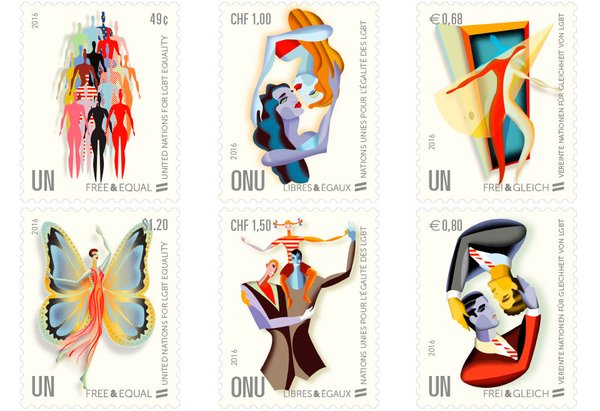lgbt
Gay Marriage in NY
Quick sketch tonight:
NYT:
“On Friday night, as the Senate voted, a crowd jammed into the Stonewall Inn, where televisions were tuned to the Senate hours before the vote began. Danny Garvin, 62, said he had been at the bar the night of the riot, and came back to watch the Senate debate Friday. On the streets where police beat gay men in 1969, on Friday crowds cheered, as police quietly stood watch.”
From riots to public policy in just 40 years.
And barely two hours after the Senate vote, nyc.gov has posted an FAQ!
“With the passage of the Marriage Equality Act, people from all over the country and all round world are asking the question: can I come to New York City and get married? The answer is yes! Whether you're a lifelong local or someone who has dreamed of coming here your entire life, New York City is the ultimate spot for you to tie the knot.”
Think of the Children
In my bloggy readings, I keep finding stories of monuments and memorials sold on infantilism, using the lens of “childhood” to conjure an air of authenticity and gravitas.
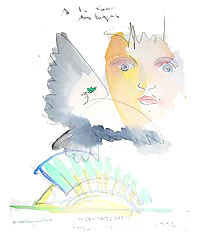 The New Yorker on Santiago Calatrava:
The New Yorker on Santiago Calatrava:
“In Liège, Belgium, Calatrava was one of seven contestants in an architectural competition to design a high-speed-train station. His rivals came in teams, armed with examples of their past work; Calatrava showed up alone, with his paintbrush [and watercolors], and won the commission. In January, 2004, while presenting his proposal for a new PATH transit hub for the World Trade Center site, Calatrava drew in chalk a child releasing a bird from her hands, thus conveying the genesis of the design, in which a pair of glass-and-steel canopies would arch over the sidewalks of lower Manhattan, like outstretched wings.”
The Washington Post on Ralph Appelbaum:
“When he took on the task of designing a presidential library for former Nigerian president Olusegun Obasanjo, for example, he proposed focusing the displays on the question, ‘What does it take to make a Nigerian child?’ It’s an unanswerable question, but it provided the necessary aha moment that made it all come together, a positive theme that finesses some of the philosophical problems of a presidential library in a country riven by corruption, violence, and religious, ethnic, linguistic and economic divisions.”
The Independent on Daniel Libeskind and his World Trade Center design:
“But Libeskind, a Polish American who now lives in Berlin, captured the hearts of New Yorkers when he appeared live on CNN during the final stages of the competition and said: ‘Like so many others, I arrived by ship in New York harbour as a teenager and as an immigrant. The Statue of Liberty and the Manhattan skyline made an unforgettable impression, and this scheme is all about that.’ ‘The minute he said that, he had the job,’ says Doris Saatchi, the New York art collector. ‘It’s not showmanship. He just expresses emotion so well.’”
Meanwhile, actual kids are moving adults to make responsible policy. See Democracy Now!: Testimony of 12-Year-Old with Two Moms Moves Some Vermont Legislators to Support Gay Marriage Bill.
East Village Memorial
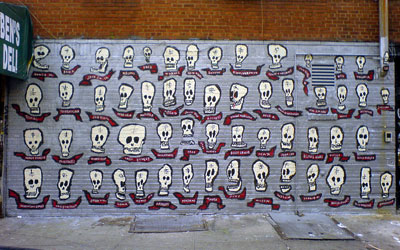
This memorial is painted on the side of Mamma’s Food Shop on 6th street and Avenue C. Click the image above for a larger version. The mural is signed by Taboo!, an East Village drag queen. I couldn’t find much about her online except mention (and a photo) in this old Wigstock release.
The piece commemorates a mix of stars, artists, drag queens, and others. Some died of AIDS, others were East Village locals. Some names I recognize, others I do not. Members of a family quietly fading.
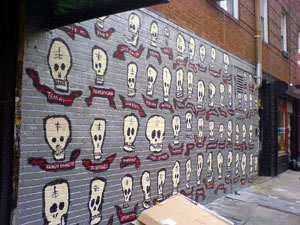
No Gay Marriage in the Netherlands
In July, the Vatican called on Roman Catholics around the world to oppose the legalisation of marriages between same-sex couples. In response to the Vatican’s campaign, Dutch gay rights organisations have published manual on how to revoke the legal ban on same-sex marriage in your country.
From AFP:
“The 60-page step-by-step booklet, published in Dutch and English, gives a historic overview of the 16-year lobbying process that eventually led the Dutch government to allow gays and lesbians to tie the knot as of April 1, 2001.
It calls on gays all over the world to challenge discriminatory laws and fight for equal rights through the courts.
In a sense it is a how-to manual for gays abroad campaigning for the right to same-sex unions says Henk Krol, editor in chief of the Gaykrant gay weekly, who created the booklet together with gay rights organisation COC Netherlands [the civil rights group that organized the successful lobby.]...
The manual is [also] intended to help authorities abroad see how they can change legislation, [Amsterdam mayor Job] Cohen added.
The booklet will be sent to foreign gay organisations and will be available online through the Gaykrant and COC websites.
For gays seeking advice on the possibility of marriage in the Netherlands Krol offers some practical tips in the preface to the booklet.
‘A foreigner living with a Dutch man or woman can marry. Two foreigners living permanently in the Netherlands also have this possibility,’ he writes.
For Europeans living in the European Union it could be possible to claim access to the Dutch institution of civil marriage through the European courts, the text suggests....
The manual is called ‘No gay marriage in the Netherlands’.
Dutch gay rights organisations insist that gay marriage does not exist here because under Dutch law it is the same civil union as is entered into by heterosexual couples. There is no special arrangement for same sex unions.
According to the latest statistics, more than 4,300 same sex couples chose to tie the knot in a civil marriage by 2002.”
The text is not yet available online, though the manual is for sale here.
SILENCE = DEATH
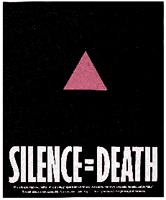 From the Encyclopedia of AIDS:
From the Encyclopedia of AIDS:
“The pink triangle was established as a pro-gay symbol by activists in the United States during the 1970s. Its precedent lay in World War II, when known homosexuals in Nazi concentration camps were forced to wear inverted pink triangle badges as identifiers, much in the same manner that Jews were forced to wear the yellow Star of David. Wearers of the pink triangle were considered at the bottom of the camp social system and subjected to particularly harsh maltreatment and degradation. Thus, the appropriation of the symbol of the pink triangle, usually turned upright rather than inverted, was a conscious attempt to transform a symbol of humiliation into one of solidarity and resistance. By the outset of the AIDS epidemic, it was well-entrenched as a symbol of gay pride and liberation.
In 1987, six gay activists in New York formed the Silence = Death Project and began plastering posters around the city featuring a pink triangle on a black background stating simply ‘SILENCE = DEATH.’ In its manifesto, the Silence = Death Project drew parallels between the Nazi period and the AIDS crisis, declaring that ‘silence about the oppression and annihilation of gay people, then and now, must be broken as a matter of our survival.’ The slogan thus protested both taboos around discussion of safer sex and the unwillingness of some to resist societal injustice and governmental indifference. The six men who created the project later joined the protest group ACT UP and offered the logo to the group, with which it remains closely identified.
Since its introduction, the ‘SILENCE = DEATH’ logo has appeared in a variety of manifestations, including in neon as part of an art display and on a widely worn button. It was also the forerunner of a range of parallel slogans such as ‘ACTION = LIFE’ and ‘IGNORANCE = FEAR’ and an entire genre of protest graphics, most notably including a bloodstained hand on a poster proclaiming that ‘the government has blood on its hands.’ Owing in part to its increasing identification with AIDS, the pink triangle was supplanted in the early 1990s by the rainbow as the dominant image of ‘gay pride.’ By force of analogy, however, the rainbow itself has, in some countries, become an image associated with AIDS.”
via ACT UP NY:
“There was also the SILENCE=DEATH Project, which was a group of men who had started meeting a year and half before [ACT UP was started], including Avram Finklestein, Oliver Smith, and Chris Lione. They were a whole group of men who needed to talk to each other and others about what the fuck were they going to do, being gay men in the age of AIDS?! Several of them were designers of various sorts—graphic designers—and they ended up deciding that they had to start doing wheat-pasting on the streets, to get the message out to people: ‘Why aren’t you doing something?’ So they created the SILENCE=DEATH logo well before ACT UP ever existed, and they made posters before ACT UP ever existed, and the posters at the bottom said something like, ‘What’s really happening in Washington? What’s happening with Reagan and Bush and the Food and Drug Administration?’ It ended with this statement: ‘Turn anger, fear, grief into action.’ Several of these graphic designers were at that first evening that Larry spoke.”
Big ’up to v-2.
HIV / AIDS / WWW
“Each December 1, World AIDS Day, the creative community observes A Day With(out) Art, in memory of all those the AIDS pandemic has taken from us, and in recognition of the many artists, actors, writers, dancers and others who continue to create and live with HIV and AIDS.
A Day With(out) Art was created by the group Visual AIDS in New York City.
 For the last several years, Creative Time has organized a Day With(out) Art observance on the worldwide web, encouraging diverse website designers and administrators to darken their site and convey AIDS prevention and education information to their visitors.
For the last several years, Creative Time has organized a Day With(out) Art observance on the worldwide web, encouraging diverse website designers and administrators to darken their site and convey AIDS prevention and education information to their visitors.
In 1999, more than 50 webloggers took part in a project called a Day With(out) Weblogs. In 2000, nearly 700 personal weblogs and journals of all sorts participated. In 2001, the number was over 1,000. The personal web publishing community — weblogs, journals, diaries, personal websites of every kind — has continued to grow and diversify.
Once again, everyone who produces personal content on the web is invited to participate a global observance of World AIDS Day. In recognition of the variety of sites participating — E/N sites, weblogs, journals, newspages and more — and to differentiate it from other, similar endeavors, a Day With(out) Weblogs became Link and Think.”
Despite the corny name, Link and Think is one of the more effective online grassroots marketing campaigns I’ve seen. While a Day With(out) Weblogs was more of a memorial and show of solidarity, Link and Think also takes a more forward looking view.
Of the Web logs I check regularly, MetaFilter posted decent set of links. The facts, stories, and images are chilling, but it’s also nice to see a bit of perspective — for instance, asking why AIDS dominates the public health debate.
Coloring Books
From Common-Place Book:
“In a scheme so wacky, it could only be COINTELPRO, the FBI sent something called The Black Panther Coloring Book to families across the United States, in an effort to subvert white support for black civil rights. The drawings are fabulously blaxploitation-meets-the-revolution.
‘This coloring book, which was purported to be from the Black Panthers, had actually been rejected by them when it was brought to them by a man later revealed to have intelligence connections. Not to be troubled by the fact that the Panthers found the coloring book revolting, the FBI added even more offensive illustrations, and mass mailed it across America... [The truth was revealed] in the Congressional inquiry into COINTELPRO.’ [source]
The Cunt Coloring Book by Tee Corinne was first published in 1975. It was a Judy Chicago kind of feminist gesture, became a cult favorite in the lesbian community, and in still in print. It was controversial enough on first publication for Corinne to change the title to Labia Flowers. It continues to be controversial enough to send to US Senators.
‘Last September, one of her pioneer efforts, The Cunt Coloring Book (1975), was the subject of a right-wing political attack on James Hormell’s nomination as a U.S. Ambassador. The Traditional Values Coalition sent a packet of materials (including Corinne’s book) to all 100 U.S. Senators, noting that the materials were in the collection of the Hormell Gay and Lesbian Center at the San Francisco Public Library. Her photocopied book and a pack of crayons were sent in an attempt to discredit Hormell, an openly gay man, who had helped to fund the Center.’ [source]”
Reprinted with permission.


